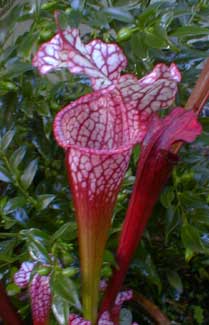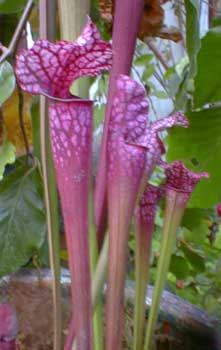
'Dana's Delight'
Fluted Red Pitcher Plant
or Bog Bugles
"And this dark chalice is the Pitcher-Plant,
Stored with the water of forgetfulness.
Whoever drinks of it, whose heart is pure,
Will sleep for aye 'neath foodfull asphodel,
And dream of endless love."
-Tecumseh: A Drama
by Charles Mair
(1838-1927)
by Charles Mair
(1838-1927)
 Carniverous pitcher-plant, native to eastern North America, are so unusual that they were bound to attract interesting folklore. The Native American belief recorded by Charles Mair in his poem Tecumseh (as quoted above) states that to drink water from a pitcher-plant causes erotic dreams or, like water of the Lethe, forgetfulness.
Carniverous pitcher-plant, native to eastern North America, are so unusual that they were bound to attract interesting folklore. The Native American belief recorded by Charles Mair in his poem Tecumseh (as quoted above) states that to drink water from a pitcher-plant causes erotic dreams or, like water of the Lethe, forgetfulness.This doesn't strike me as entirely likely to be an authentic Indian belief if only because to drink captured water from a randomly encountered pitcher-plant would be pretty gross, considering that the pitcher will also be crammed with decayed or drowned ants & moths & other insects upon which pitcher-plants feed. And the myth of the Waters of Oblivion is from the ancient world of Europe & the Near East, & an entirely different kind of pitcher-plant or Cobra-lily (Nepenthes spp) was associated with (& named after) the Waters of Oblivion in India.
 So Mair's poem would seem to mix up some mythologies & might never have applied to Tecumseh the famed Shawnee warrior who fought against incursions of white immigrants in the late 1700s.
So Mair's poem would seem to mix up some mythologies & might never have applied to Tecumseh the famed Shawnee warrior who fought against incursions of white immigrants in the late 1700s.But Mair's poem might well reflect a European understanding or interpretation of something similar believed in aboriginal America. For among native peoples, leaves & roots of various species of Sarracenia were used to treat a number of serious contangions introduced by white settlers, from smallpox & whooping cough to liver disease. And I can well imagine oblivion &/or hallucinations followed these diseases with or without use of pitcher-plants in various concoctions.
Even though Tecumseh's association with pitcher-plants is awfully tentative, I've included his portrait on this page for the heck of it, cuz he was a cool dude. Certainly the confederacy of tribes he united from the Great Lakes Region to Florida & Mexico would have been as well-acquainted with pitcher-plants as Mair assumed.
'Dana's Delight' pitcher plant can produce pitchers up to three feet tall, though ours has only gotten up to two feet so far. A regular Sarracenia leucophylla or white-top pitcher plant with green & bright white pitchers has been hybridized with the S. willisii, which lends 'Dana's Delight' its bright pink & white veining, aging to deeper red.
The hood of the pitcher is ruffled with lattice webbing & wider than the white-top pitcher. The whole upright pitcher is one of the tallest, most intensely colored, hence showiest of any carnivorous plant.
The pale spots on the back of the hood & backside of the pitcher are called fenestrations (transluscent light-windows) & they let sunlight into the flower. This wondrously ornamental feature is thought to have the practical value of confusing trapped insects which try to exit by the light. The front of the pitcher has a reenforcement ridge called an ala (wing) which ants use to climb to the top of the pitcher in single-file, some of them making it back down the ala with a drop of nectar, but others becoming meat for the pitcher-plant.
Pitcher plants require a lot of sunlight & persistent bog conditions, ideal for swampy areas, pool edges, or containers lacking draining holes. If grown in containers, they do not need to be deep pots because the root system of carniverous plants is minimal. Our 'Dana's Delight' is in a pot with decorative piercings around the top edge which allow the water to drain out of it two or three inches down in the pot, as these plants don't really want the water level to be higher than the top of their root crown. The decorative piercings provide drainage at exactly the level of the root crowns.
The soil medium in this pot is about half coarse sand & half peat. Pitcher plants like most carniverous plants require nutrient-poor soil. Even moderate fertilizing can damage or kill the otherwise extremely long-lived root. I've packed sphagnam moss on the surface of the pot to protect the root from being baked in the full sun & to restrict evaporation. 'Dana's Delight' shares this pot with a Carolina Mountain Sidesaddle Flytrap (Sarracenia purpurea ssp venosa var montana) which practically lays prostrate, & being nested on the sphagnam keeps its leaves from getting muddied by the sand & peat.
Very active spring through summer, right up to October or later, it frequently produces its best pitchers in autumn. The pitchers wear out in winter & should be cut off as each pitcher blackens. But there are some late-occurring "closed" leaves called phyllodia that are apt to last through winter.
Ours came from Courting Frogs Nursery in Stanwood, Washington. They are a wholesale grower, whose plants can be gotten from the Indoor Sunshop in Seattle or in Tacoma from Jungle Fever. But 'Dana's Delight' by right of its extreme beauty is one of the more widely distributed tissue-cultured hybrids & should be easily tracked down from any carnivorous plant specialist.
Darlingtonia californica,
carnivorous Cobra Lily